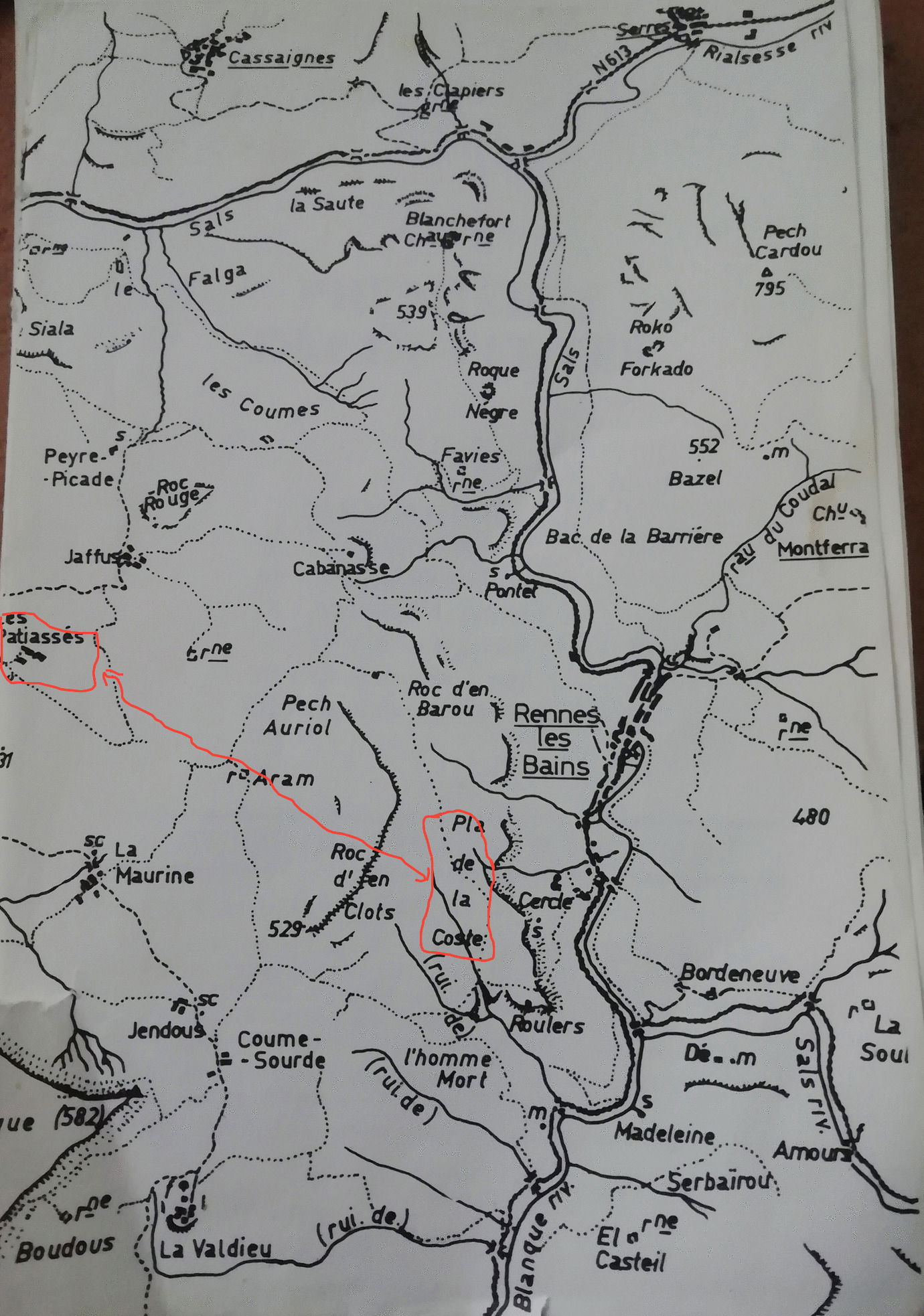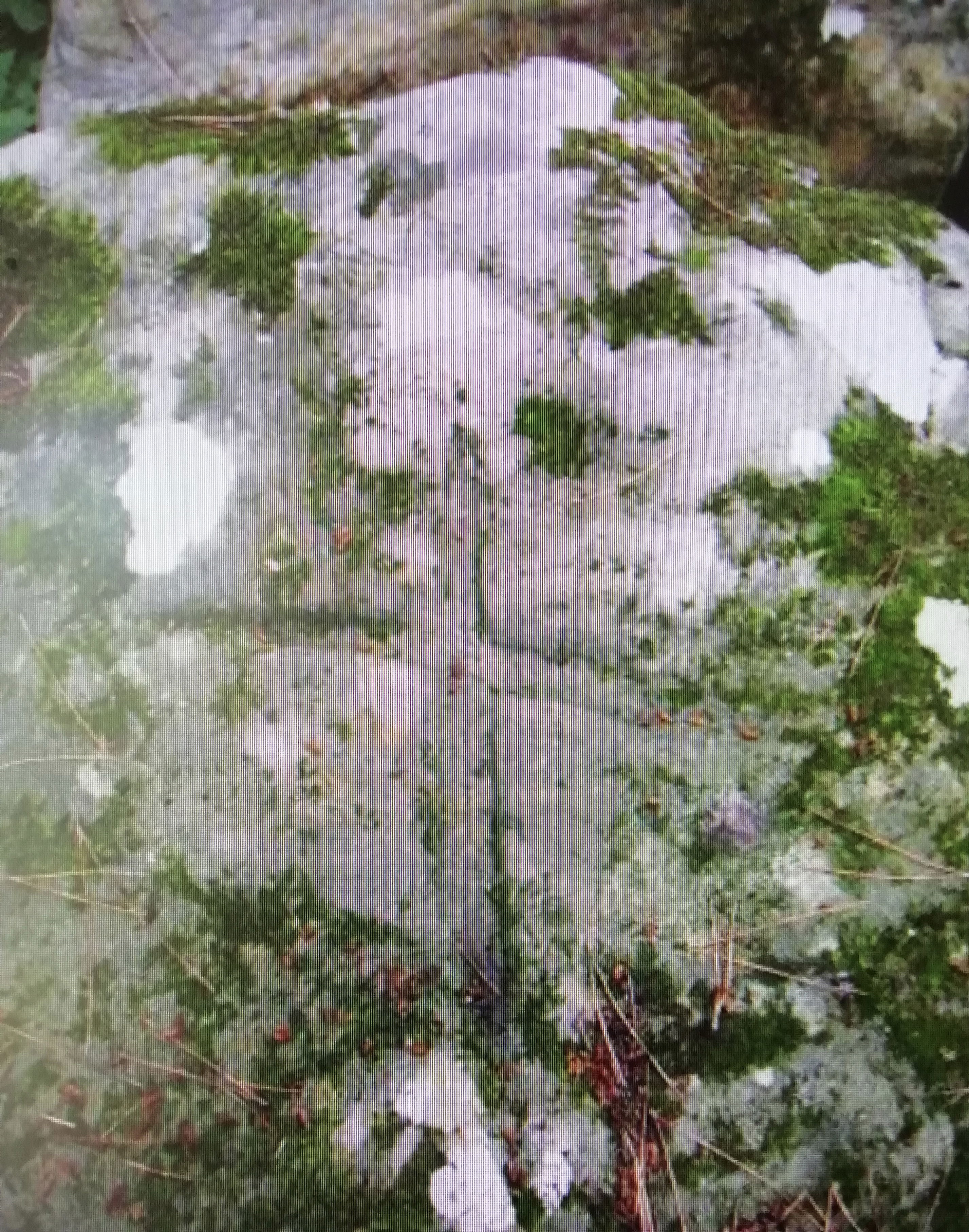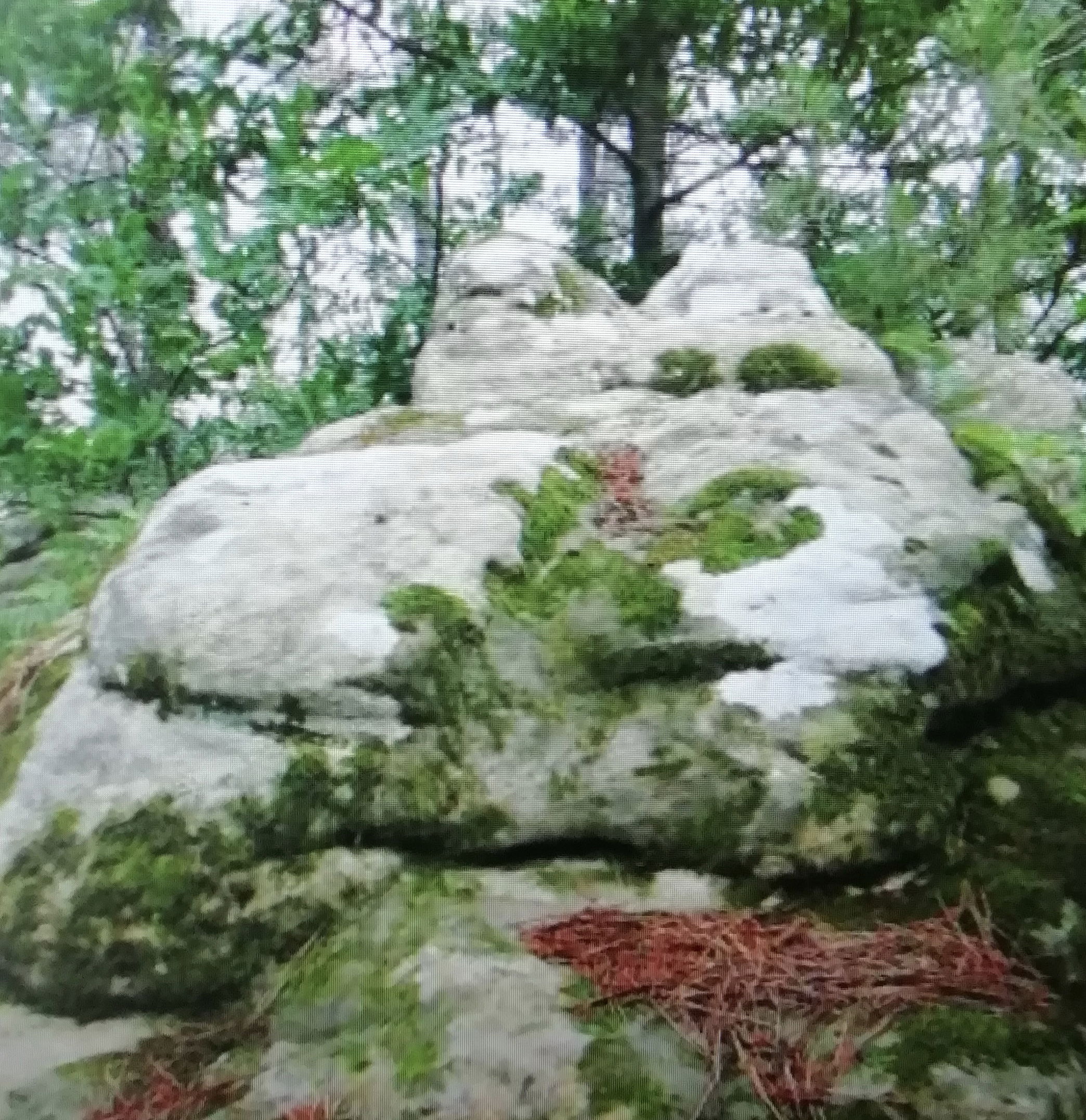The daemon guardian of the Bergere cipher is Henri BOUDET!
Why?
In August 1965 a document known as Les descendants mérovingiens ou l’énigme du Razes Wisigoth appeared. The deposition notes claim that the document was published at Genève: Alpina, in August 1965. It was written by an annoymous Madeleine Blancasall, perhaps a name in honour of Mary Magdalene and the two rivers called the Blanque & and the Sals which flow through the village of Rennes-les-Bains. The document was deposited in the Bibliothèque Nationale of Paris and it says is translated from the German by Walter Celse-Nazaire, again probably named after the patron saints of the church of Rennes-les-Bains.
There are several important 'developments' in this early 'text'. What we have in 1965 is the important part played by Abbe Boudet. Blancasall says that Saunière even consulted Boudet for advice and further information in his discoveries.
Blancasall says that "assisted by Marie Denarnaud, his [Sauniere's] first concern will be to obliterate the tombstone of the Marquise de Blanchefort. Then, he takes walks alone in the countryside - on the hill of Patiaces and Pla de la Coste. After a few days, he found the trail signs leading to the famous menhir called cheval de dieu and the cross on the ?stone of crete [or ?stone ridge] 681 yards from the shepherdess [large chair?] of the church of Rennes-les-Bains. He then goes to Abbe Boudet for advice on this daemon guardian". [my emphasis & my additions in brackets].
Another translation of the paragraph is as follows; "Assisted by Marie DENARNAUD, first he [Sauniere] will smooth out the tombstone of the Marquise de BLANCHEFORT, then he walk's alone in the countryside on the side of "Patiacès" and "Pla de la Coste". In a few days he found the trail signs: the famous raised stone called the Cheval de Dieu [Horse of God], the Cross on the stone ridge/crest at 681 toises from the bergere [?Shepherdess/armchair] of the church of Rennes-les-Bains", the priest then goes to BOUDET to ask him for advice "on this half-way [or midday? Meridian?] guardian daemon of the blue apples", - an agreement is undoubtedly concluded, because in March 1891, the life of Abbot SAUNIERE changes completely".

Above - Places marked in red where Saunière investigated.
In this 1965 snapshot of the so-called Priory of Sion information as it was being disseminated then - described elements of the 'bergere' cipher message in a geographical context. This 'bergere' cipher message is precisely the cipher square encoded by Cherisey as identified by Andrews & Schellenberger.
It would seem to me that the geographical clues are the ones we should follow despite the multitude of false trails and obfuscation he often writes about. Within his alleged document Stone & Paper for example not only could bergere refer to an armchair in the locality, and 681 [PAX 681] to the length of toises from the Greek Cross, on the ridge referred to by Boudet, 'bergere' also referred to the 'bonne colline' - the beautiful hill which is Mount Serbairou. This hill is itself associated with a shepherdess and treasure legend. The shepherdess wakes up early one day to see the Devil spreading his treasure in the sun. 'Toute la bonne colline en etait illuminee ['the entire beautiful hill was lit by it']. Cherisey said that, if at sunrise, the shepherdess was dazzled by the reflection of the gold, and not the gold itself, it was because the sun was behind her and therefore she was looking west. Thus it was important to know where the shepherdess was rather than where she was looking.
The second paragraph translation given above is interesting because it suggests that Sauniere required further information on this geographical circuit he was completing on foot. It depends on the myriad of different interpretations of the texts - for example the word daemon can mean;
'following, or waiting' on the guiding spirit [ie Boudet] to provide further information. The 'a midi' could mean in a half tour [or turn] and pommes can also refer to any spherical or round shape, so in this context a tour/circuit around a geographical rebus in Rennes-les-Bains could be being indicated. In its totality this could mean, according to Blancasall that Sauniere, to complete his tour [a circuit] and search of the country of Rennes-les-Bains he required the input and help of the guardian/guardien of the place and its sanctuary, Henri Boudet'.
Cherisey says [in Stone & Paper] that " ... Berenger Sauniere found various signs left by Father Bigou. He often wandered in a land called 'Le Pla del Coste' and a strange chess game started between Roc Noir [Rokko Negro] and the Rocher Blanc [White Rock]. The priest found the famous standing stone, known as the Cheval de Dieu, and the thirty-five centimetre stone cross on a ridge mentioned by Father Boudet, located 681 toises [one toise equals 6 feet or 1.949 metres] from La Bergere de l'eglise de Rennes-les-Bains".
The only famous standing stone in the Rennes-les-Bains area is the Peyro-Dreito stone, the Menhir de Pontils. But i fear this is too far away from Rennes-les-Bains and does not fit the current geographical setting.
So if the Bergere/armchair [ie Devils Armchair] of the church of Rennes-les-Bains is 681 toises from the Cheval de Dieu and the stone ridge/crest of Boudet, this must be on Mount Serbairou. Cherisey says the Cheval de Dieu is at the top of this hill. He writes;
'at the spot where the shepherdess noticed the reflection of a treasure, there are two beautiful white standing stones very similar to a large horse and a small one trotting side by side. The other area is more accesible; one is even forced to go through it on the road from Couiza to Rennes-le-Chateau, where it pierces the rock face via an aperture narrow enough to have hosted a guardroom in the past'.
At the top of the Serbaïrou the rock formation that was also described by Boudet in La Vraie Langue Celtique , on page 245: is found a very large Greek cross, exactly as Boudet claimed. It is pictured below:

Also near here is another strange rock formation - is this Cherisey's Cheval de Dieu? It is behind the rock with the Greek cross & is a second upright rock, which looks to have been worked by human hands. At the top of that rock is a hollow, which makes it seem to function as an observation point - when one looks through the observation rock, one sees top of the mountain Cardou. The Blanchefort rock is also visible.


Boudet wrote that the stone cross/ridge - was found near the;
'plateau called the Cap de l'Hommé.... to the left of the menir of the Cap de l'Homme looking at the spa and its parish church, one could discover on the neighbouring rocks Greek crosses deeply engraved by the chisel and measuring from twenty to thirty and thirty-five centimeters. These crosses, with equal branches and five in number on this single point, must have been engraved by order of the first Christian missionaries sent to the region".
It is in Boudet's book, La Vrai Langue Celtique - on page 244 that it says that by a square rock [the De?] there is the entrance to a cave and dolmen. It is also confirmed that directly above the dolmen is a rock crest/crest of a ridge that bears a Greek cross carved in stone, the largest cross of all! So Henri Boudet felt the most important cross was this Cross of Crete, or Cross on a ridge, and it was near a dolmen on Serbairou/road to Sougraine. In the Priory 'mythology' it is Sauniere who 'After a few days, ...found the trail signs leading to the famous menhir called cheval de dieu and the cross on the ?stone of crete [or ?stone ridge] 681 yards from the shepherdess [large chair?] of the church of Rennes-les-Bains'.
So Sauniere was heading towards Serbairou.
Boudet writes:
"A second cromleck, of a smaller extent, is enclosed in the one we have tried to trace. Starting from the hamlet of Cercle, towards the middle of the side of the mountain, it follows the Illète to the Trinque Bouteille stream, then emerges on the slope of the Serbaïrou closest to the rivers of Blanque and Sals, resumes at Roukats, to end in front of the hamlet of Cercle, its starting point. One might be rightly surprised not to find any dolmen among these Celtic monuments. We found seven; five on the flanks of Serbaïrou, and two in Roukats. The most remarkable is located opposite the Borde ‑ Neuve, very close to a large square stone, strangely balanced on a rock. This dolmen, closed at one end, offers the image of a cave. By standing on the path leading to Sougraignes, the eye easily distinguishes the structure of all its parts. At the top, directly above the dolmen, a rock of the crest [ridge] bears a Greek cross carved in stone: it is the largest of all those that have been given to us to recognize. Approaching the old path of Bugarach, at the same height as that of the dolmen, an enormous rock is adorned with a fairly strong stone having the round shape of bread [pierre du pain]".
The same information pops up in a later Secret Dossier File, in a much more famous file called Le Serpent Rouge. In the verse of Libra it says:
"At the window of the ruined house I gazed across the trees stripped by autumn to the summit of the mountain. The cross of crete stood out under the midday sun, it was the fourteenth and the biggest of all with its 35 centimetres!"
With all these landmarks being in the area of Rennes-les-Bains this perhaps explains why Sauniere [according to Blancassall] visited Boudet for advice on this daemon de gardien.
According to Blancassal Sauniere has just been walking the local countryside of Rennes-les-Bains & it is after this walkabout that he decides to visit Henri Boudet for advice. Boudet is described as the daemon de guardian 'of this place'! This place is either the area Sauniere was searching or Rennes-les-Bains in general. This suggests that the daemon de guardian is some kind of circuitous route in the landscape of Rennes-les-Bain as well as in parallel referring to [as in Classical Mythology] a god, or a subordinate deity, or the genius of a place [as in the classical Roman religion, a genius loci was the protective spirit of a place. It was often depicted in religious iconography as a figure holding attributes such as a cornucopia, patera or snake] or a person's attendant spirit or finally an actual demon.
Therefore, within our context, Boudet surely is the actual 'daemon guardian' of 'this place'?
Daemon comes from the Latin daemon & itself is borrowed from ancient Greek δαίμων [daímōn] which designates different things according to the authors and the times but generally refers to a kind of spirit of the supernatural world. Among other meanings it also denotes "divine power". The ancient Greek name may have come from the Greek root dai- & the verb δαίομαι daíomai; "to divide, distribute" and the suffix; -mōn.
In popular Greek culture, a demon referred to a kind of ambivalent genius, a being endowed with supernatural powers, capricious and unpredictable, present in strange places at particular times and at work in the frightening events of nature and human life, but capable of being appeased, controlled at least by magical means. The Romans had gods, goddesses, manes (souls of the dead), lares (tutelary spirits protecting houses, etc.), genii (spirits presiding over the destiny of a place, of a group, of an individual), lemurs ( specters of the dead) etc...
Démon gardiens are also known as Les veilleurs. What we call watchmen or sometimes guardian demon's is actually a higher entity; these are most often the demons of goetia, fallen angels or, sometimes, pagan deities. hese higher entities impart their occult and spiritual teaching to people who have already reached a certain stage in their evolution.
In Homer the term is used almost interchangeably with theos for god. The distinction here is that theos emphasizes the personality of the god, and demon his activity. Hence, the term demon was regularly applied to sudden or unexpected supernatural interventions not due to any particular deity. It became commonly the power determining a person’s fate, and a mortal could have a personal demon.
In contrast a GARDIEN is a keeper [conservateur, surveillant, geôlier, ] or [protecteur, ange gardien] or a custodian [conservateur]. The Collins French-English dictionary writes: gardien [ɡaʀdjɛ̃ ] Word forms: gardien, gardienne
MASCULINE NOUN/FEMININE NOUN
1. (= garde) guard 2. [de prison] warder ⧫ 3 guard. [de domaine, réserve] warden 4. [de musée] attendant 5. [de phare, cimetière] keeper [d’immeuble] caretaker 6. (figurative) (= protecteur) guardian
So it is quite clear for Blancassell - Boudet, is the person able to maintain & preserve something. He was the guardian of the tradition of the area. That is - Boudet was the guardian of some local mystery at Rennes-les-Bains. Daemon as the guardian spirit of a place - certainly describes Boudet. Gardien as a person who has custody, or who is responsible for protecting or monitoring someone or something [in Boudet's case, the secret of a local mystery in Rennes-les-Bains which he actually admits to in his book The True Celtic Language & the Cromleck of Rennes les Bains'!] or one, who protects & preserves something - which some say Boudet did and to which he also gave credence to in his famous book 'The True Celtic Language'! In this book are the keys to a local mystery at Rennes-les-Bains - usually interpreted as an important and mysterious burial in the area, centrally located in his Cromleck.
So in 1965, 2 years before de Sede published his book, we find references to the existence of a Menhir called the Horse of God, and a mysterious cross of crete carved on a stone. The 'cheval de dieu' was part of the secret message discovered once the Sauniere parchments had been deciphered. [Later, in Cherisey's CIRCUIT novel, finally published in 1971or thereabouts but known to have been written much earlier the 'cheval de dieu' also becomes the 'Horse of God' in one of the Delacroix paintings at Saint Sulpice, and in some strange way a reference to a car, a Citroën 2CV - French "deux chevaux" i.e. "deux chevaux-vapeur" (lit. "two steam horses"].
Comments